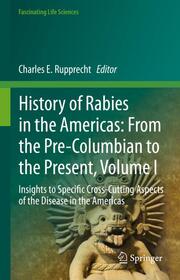Detailansicht
History of Rabies in the Americas: From the Pre-Columbian to the Present, Volume I
Insights to Specific Cross-Cutting Aspects of the Disease in the Americas, Fascinating Life Sciences
ISBN/EAN: 9783031250514
Umbreit-Nr.: 7671558
Sprache:
Englisch
Umfang: xvi, 319 S., 1 s/w Illustr., 319 p. 1 illus.
Format in cm:
Einband:
gebundenes Buch
Erschienen am 25.04.2023
Auflage: 1/2023
- Zusatztext
- Rabies is one of the oldest known pathogens, is incurable, and has the highest fatality rate of all infectious diseases. The Americas is the only region with bat rabies virus, including vampire bat rabies. The region is rich in cultural references and notable for many discoveries in the field, including the current vaccine potency test, diagnostic assay, conception of oral vaccines for wildlife, the first human survivor and the first successful canine rabies program executed at a broad level. Rabies remains the most important viral zoonosis, with tens of thousands of human fatalities and tens of millions of exposures annually, which can be used to model for other pathogens, such as COVID-19. There is an international effort to eliminate human rabies caused by dogs over the next decade, and the Americas represent the primary region with the greatest proof-of-concept evidence to accomplish this goal. This twovolume set addresses the medical history and modern results of rabies in countries throughout the Americas, including the implications of and on cultural, economic, sociological, and research developments in the region. Volume I presents an overview of concepts critical to the study of rabies in the region, including evolutionary aspects, reservoir ecology and control, elimination efforts, vaccine development, and disease hallmarks and progression. It also analyzes the longterm cultural, social, and economic impacts of the disease in the Americas.
- Kurztext
- Rabies is one of the oldest known pathogens, is incurable, and has the highest fatality rate of all infectious diseases. The Americas is the only region with bat rabies virus, including vampire bat rabies. The region is rich in cultural references and notable for many discoveries in the field, including the current vaccine potency test, diagnostic assay, conception of oral vaccines for wildlife, the first human survivor and the first successful canine rabies program executed at a broad level. Rabies remains the most important viral zoonosis, with tens of thousands of human fatalities and tens of millions of exposures annually, which can be used to model for other pathogens, such as COVID-19. There is an international effort to eliminate human rabies caused by dogs over the next decade, and the Americas represent the primary region with the greatest proof-of-concept evidence to accomplish this goal. This twovolume set addresses the medical history and modern results of rabies in countries throughout the Americas, including the implications of and on cultural, economic, sociological, and research developments in the region. Volume I presents an overview of concepts critical to the study of rabies in the region, including evolutionary aspects, reservoir ecology and control, elimination efforts, vaccine development, and disease hallmarks and progression. It also analyzes the longterm cultural, social, and economic impacts of the disease in the Americas.
- Autorenportrait
- Charles E. Rupprecht is a World Health Organization Expert Technical Adviser on Rabies, retired as the head of the rabies program at CDC. He has co-authored over 400 peer-reviewed papers, written scores of book chapters, edited several books and served as an editor for several journals.
